Exophilie - Postmortem
For a better reading experience, this postmortem is also available on my website: http://frederickmaheux.com/exophilie-postmortem/
Il appartient à la perception de pulvériser le monde, mais aussi de spiritualiser la poussière. -Gilles Deleuze-
Introduction: Anticosmic invasion of formless prurient noise
Exophilie materialized into this dust matrix through an urge to return to harsh noise with my industrial project Un Regard Froid. Past albums fell between noise and power electronics, strongly emphasizing lyrical contents, martial rhythms, and prepared loops. The call of physical improvisation with my tools, of confronting contingency as a creative process, led to hours of recording with various metal textures and devices such as vibrators, power tools, etc. This cycle lasted for months, trying to achieve synthesis with the piercing tension to transcend my flesh through several noise marathons. After initial testing with pedal chains, contact mics positioning, and other parameters, the apparatus remained the same. The aim was to intensify the contingent relationship between the setup and me: for the whole project to act as an interpenetration between noise and meat. This approach draws similarities to DiPiero's thoughts about improvisation and contingency:
Thinking contingency takes the premise of interdependence to its furthest extreme: in this view, it is not that discrete, isolated entities connect themselves to form something greater, but rather that the distance between the musician as subject and the instrument as object is not clearly defined. […] The notion of contingency emphasizes the fact that the improvisation, in a deep way, depends – that is, it is not made up of component parts that get connected together, because the component parts do not pre-exist as isolable entities: they are already contaminated with one another as they are expressed in the event. (DiPiero, 2018, p.3)
The anchor in terms of visualizing and directing sounds came from this short sample from the sci-fi horror game Prey (2017) :
"I keep having this... dream. I'm just staring into the black, between the stars. There's something there. I know there is. I just can't see it... but it sees me. I can feel it... hate us. I know you know what I'm talking about. Or you will soon."
That audio log resonated with the literature I was exploring – Lovecraft, Ligotti, object-oriented ontology, accelerationism, posthumanism, etc. There was in these few words a brilliant bridge between something more terrifying than cosmic indifference: hatred. However, hatred also implies love, and love implies the possibility of erotism. And further down this Bataillean path, ecstasy and the impossibility of communication. Recording the noise led me further onto that diffractive path, mixing concepts and ideas that solidified through reading:
- Graham Harman's Weird Realism, specifically this passage concerning the unique style of Lovecraft and the possibility of a Lovecraftian pornography[1] :
- A literary “weird porn” might be conceivable, in which the naked bodies of the characters would display bizarre anomalies subverting all human descriptive capacity, but without being so strange that the erotic dimension would collapse into a grotesque sort of eros-killing horror. We will see that while the stylistic production of gaps augments Lovecraft’s power to depict monstrous horrors, the horrors themselves must occur on the level of literal content, not of literary allusion. Lovecraft as an author of horror writes about horrific content (monstrous creatures more powerful than humans and with no regard for our welfare), while Lovecraft the author of gaps is one who could have flourished in many other genres featuring many different sorts of content. (2012, p.10)
- The sovereignty of the individuals makes us aliens towards each other – a "negative community" (Bataille and Blanchot) of encrypted solitudes.
- A quote from Supervert's philosophical treatise and novel Extraterrestrial Sex Fetish: "Astronomy and pornography have been the two greatest enterprises of looking in human history" (2001, p.177).
Once satisfied with the material (and an arduous process of selection and trimming) came the process of contextualizing this mess: titles, visual concepts, etc. I usually write lyrics first, then compose and record around the text, then illustrate with paper collages. Working from a new approach, I had to depart from my usual workflow. The literary framework gave me initial tracks to explore.
Creative process: Defining the boundaries of the erotic unfathomable
Unfortunately, I could not penetrate the maze just yet. Deadlines were coming fast to finish an article (recently published on Sciences du jeu[2]) about industrial music strategies in video game designs. I believe industrial culture is transmedial and could extend to video games. I made two games to support this and discovered creators who also apply those strategies[3]. Once done, the main focus was to create an interactive visualizer for Exophilie, something you listen to and explore through 3D digital spaces. The impossible worlds born from that noise would go beyond the packaging of the CD.
Various ideas gameplay-wise came to mind, especially an on-rail shooter (next project). I have been obsessed by this quote from Bernard Perron's The World of Scary Video Games: "Gameplay fear is very difficult to embody in a more abstract system to play with - unless the system is itself thought as evil" (2018, p.251). This "impossible" project has been my main focus since my first game Acephalic (2020). I finally opted for a corrupted interpretation of walking simulators based on the "modular clusters of generic resources" defined by Hugo Montembeault and Maxime Deslongchamps-Gagnon (2019, p.6)
| Walking Simulators | Exophilie |
| Slow, solitary, and peaceful walking through post-traumatic codified space. | Stressful and ultra-saturated exploration through post-traumatic codified space. |
| Search for secrets among ruined places. | The incognizable conceals something hiding in plain sight. |
| Sense of fatalism and spectrality. | Sense of disgust and confusion. |
| Voyeuristic apprehension of everyday life. | Annihilation of everyday life. |
| First-person (dis)embodiment and ambiguous sense of identity. | First-person embodiment overload and loss of identity. |
While I admit a certain visual inspiration from brutal death metal, slam, goregrind and cybergrind, I wanted to maintain Lovecraftian energy – tentacles were unavoidable, but also what Harman describes as "a concealed background [arising] into the forefront of our awareness" (2012, p.67). To cut up medical, biological, pornographic, and sci-fi aesthetics to create a form of inhuman, extraterrestrial sexuality. The visual needed to be used as a visual component of the noise and as assets for the video game: skyboxes, terrain materials, and billboarded entities devouring the landscape. The vision was less to represent alien pornography as to propose an explorable world that's, in the fictive lore of the game, the result of a monstrously fragmented human being after coital impact with an unknowable cosmic entity. We are forever bracketed in the human experience – "One can never entirely escape the recession into one's own centrism" (Bogost, 2012, p.80) - but this was an attempt to represent speculative negative anthropometry of excessive "marks on bodies” (Barad, 2007, p.153) of the human boundaries being violently shattered, blown apart on a cosmic level by noumenal fornication.
Incompetent as a visual artist, the recent accessibility of text-to-image enabled me to experiment with the visualization of such concepts. Disco Diffusion became the main creative tool, helping me generate the visual I needed to build the world of Exophilie. I was also curious to explore the possible relationships between the low-tech creative tools used for the noise (scrap metal, broken power tools, etc.) and machine learning as a world-building apparatus. This approach was relevant to the prior steps of the project: exploring a relationship between my tools and literature about object-oriented ontology – what Eduardo Navas names metacreativity: "the implications of delegating parts of the creative process to artificial intelligence and [machine learning]" (2023, p.2). Throughout this metacreative process, three findings came to the foreground: ethic, cocreation and labor.
Finding 1: The moral shackles of AI creativity tools must be destroyed.

While maybe less user-friendly than a Dall-E or Midjourney, and more limited in format and resolution, Disco Diffusion has the distinct advantage of having no rules of conduct. Idiot that I am, the first thing I tried to do with Chat-GPT was ask it to write a script of Deep Throat (1972 in the style of Thomas Ligotti. It could not. And strangely, this is the type of style transferring (Audry, 2021, p. 140-141)) that appears (to me) to be the most interesting. It was my first insight into the current limits of techno-capitalistic access to AI technology, further accelerated with GPT-4 and the lack of transparency over safety concerns[4]. While some, Chomsky, for instance[5], will write on the one hand on the stupidity of these "machines" compared to the creativity of "mankind"; others rightfully claim a new form of potential cognition, the advent of AGI, and a line of flight to criticize folk theory and anthropocentrism :
A dominant portrait of human-centric AI posits techno-scientific regulation as key to a beneficent future in which the threats and risks of artificial intelligence are managed by normative constructions of control and containment. While contemporary proposals for “human-centered AI” envision governance controlled by public institutions that promote and support human flourishing and liberal ideals, such strongly anthropocentric responses reinforce the principle of human mastery over nonhumans. (Melamphy, 2021)[6]
However, if humanistic morality and prudishness preemptively limit this project, how can this be an eventuality? This reminded me of Katherine Behar's criticism of Ian Bogost's carpentry, rightfully emphasizing how his Latour Litanizer and Image Toy remain stuck in the "comfort zone of humanist morality" (Behar, 2016, p.21).
I here agree with Chelsea Birks (2021, p.14) and her analysis of limit cinema through the hybridization of speculative realism and Bataille : “Bataille works to interrogate rather than eradicate taboo, exposing the ways that interdiction covers over excesses while also giving rise to their very possibility”. The excess of transgression, of bridging towards the void, acts here as way to reach the void, the unintelligible. Art, according to Alexander Wilson (2019, p.51), always had a privilege access to this Outside:
But the artist knows that it is not so easy to be conquered by that otherness, to let oneself be invaded by the forces of indistinction. Perhaps nowhere has this been more explicit than in the radical artistic movements of the last century. The dissociation of the subjective act from the outcome of the artistic event was a general trend in the avant-garde’s deconstruction of modernist and humanist aesthetic ideals. There was a turn to the inhuman, the irrational, the sublime speeds of the mechanical, and the ecstasies of the random as sources of an inexhaustible spontaneity. These methods were put to the use of distancing the artist’s subjective decision-making process or intention from the resulting artistic product.
This privileged access to excess (Birks, 2021, p.22), chance, and accidents (Krapp, 2010, p. 124) appear to me to be accelerated exponentially by AI tools. Therefore, I believe any artist working with chance, chaos, error, inhuman agents and excess must explore the potentiality of these technologies and fight to liberate them of corporate moral shackles.
Finding 2: Altar of Madness
Disco Diffusion does not limit us, so I went to work generating images with various prompts where sexual organs, insects, tentacles, and fluids oozed out of my screen. The results, terrible at first, became more and more exciting as I understood the right sequences of terms, where to put nouns and adjectives, etc. Examples with Have I Been Trained comparisons:
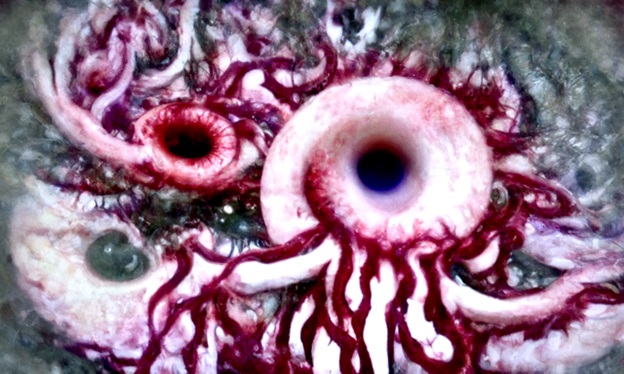
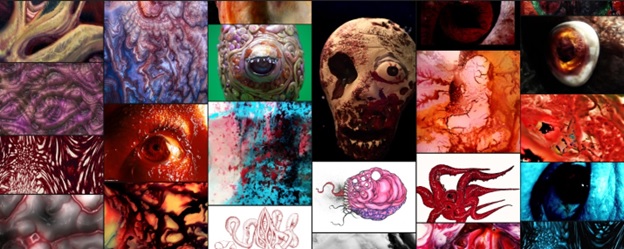

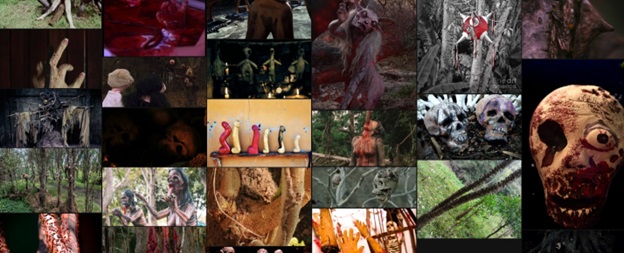
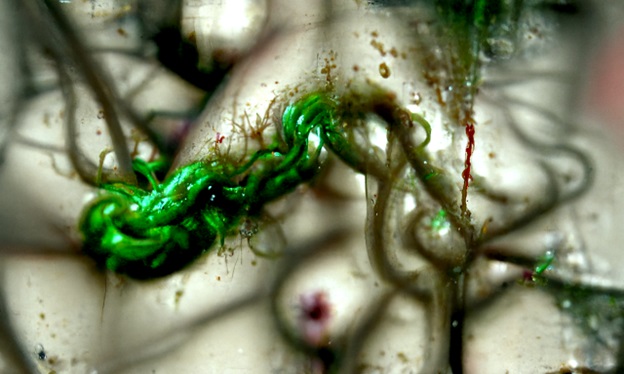
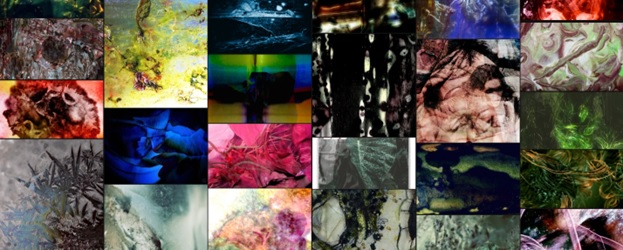
This leads me to a second insight working with Disco Diffusion to generate the visual universe of Exophilic noise. The question of metaphorizing our creative relationship with AI returns in the recent work of Sofian Audry, Oliver Bown, and Eduardo Navas: the muse, the ally, the butler, etc. However, the one that came to my mind was from the occult: the Daemon and the Altar. I had briefly been interested in Chaos Magick years ago, and the work of Phil Hine and Kenneth Grant came back to mind with the concept of the magician as a scientist. Justin Woodman thoroughly and astutely develops these ideas in his thesis:
For many Chaos magicians, magic and contemporary scientific theory are two sides of the same coin, which offer access to the primordial zones of "non-being". They represent experiences which are made explicable by becoming personalised, manifested and embodied through possession by entities which are believed to "inhabit" these metaphysical zones. This view of the demonic is located in a dialectical relationship between popular science, psychology, and magic, and thus has important implications in terms of how "modern", secular discourses have been conceptualised and utilised by Chaos magicians. Grant, for example, suggests that the qlippoth and other "forces considered by the ancients as dark and evil are now revealed by science as the anti-worlds and inner spaces of the known universe" (Grant 1980: 8). For Chaos magicians also, prior conceptions of supernatural evil are also conflated with quasi-mystical exegeses of the often puzzling realm of quantum theory and subatomic physics (see chapter four). As a consequence, occult movements often treat "rational" knowledge as imperfect and incomplete insofar as it lacks a meaningful, spiritual dimension. Thus, occult theory views itself as "completing" the "scientific" project of modernity through the integration of inner experience with the abstract theorising: Chaos magicians do not simply want to theorise about the nature of reality, but are driven to encompass and concretise it within their own, meaningful experience. (2003, p.112-113)
Magick as words that can change reality works with incantation and sigils: a demon must be named to be invoked or banished. Machine learning, especially text-to-image, appears to me as a technological continuity of this discipline. Hence, I propose a new metaphor: the altar as another step in “conspiring with contingency”. Following Wilson (2019, p.52) :
But the question of how to care for contingency, how to be receptive to indistinction, hospitable to it, or how to conspire with it, has actually been at the heart of aesthetic practices for longer than we tend to think. These themes deeply intersect art-historical discourse on authorship, style, technique, and practice: from the Greek notion of the daemon or the muse to commedia dell’arte’s improvised styles and romanticism’s investment of fatality, long before the nineteenth-century cults of madness and primitivism and the avant-garde’s explicit use of divination, chance, and automatic operations.
Text-to-image, in this project, was an altar to invoke and inspire. I also believe, as was the project of chaos magicians and certain posthumanist AI advocates, that it can breach new paths in perception and cognition when contextualized through other media such as VR, AR, etc.
Finding 3: The price to pay: grueling work.
As occultists warn, there is a price to pay with every spell. In this case, working with generated images was everything but a shortcut. Proceeding to generate the images was one thing, but making them work into a video game was another. On that note, I am not sure I entirely succeeded. The uncanny visuals it generated needed to be prepared if they were to be useable. I already had chosen to treat the entities as billboards (2D in a 3D world, always facing the player, much like Doom (1993)(), skyboxes, terrains, and UI. But the entities could not remain static. So, for each image, I carved out the relevant shapes and animated them in Adobe AfterEffects: I aimed to put out a pulsating rhythm – a work I spent weeks on while listening to Ride for Revenge's Sexual Rhythm of Death[7]. There was then the matter of implementing the creatures in the world, creating an "environment" where they acted as cancerous masses emerging from the environment – once again, the vaporized offsprings of alien fornication.


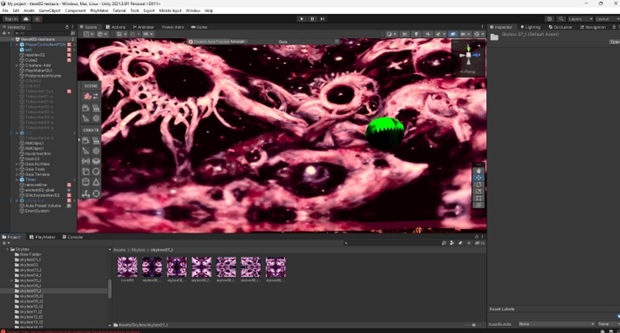
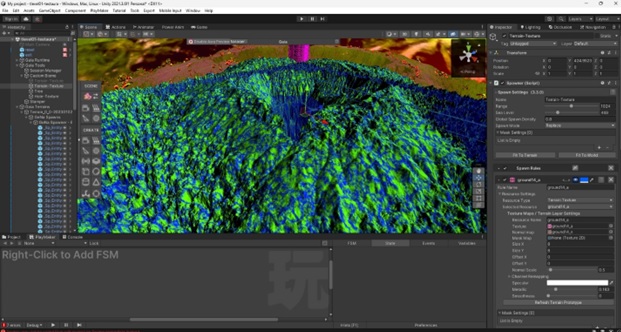

All in all, adapting the visuals took months before I wrote a single line of code. More than filtering and remixing, the challenge mainly was to extract the energy of each image and amplify it through the game and the noise. The exaltation of accessing such an infinite abyss of sublime impossibilities also came with the sheer anxiety and weariness of “making it work”.
Conclusion: Admission of partial failure revealing a way out
This creative experience delineated the massive potential of text-to-image in video game creation through industrial culture strategies: the exploration of liminality and marginality, shock tactics, and technological highjacking. As a first attempt, I see the limits of my creative process for this project: not pushing beyond human and comprehensible language, first and foremost. I was hoping the generated images inside the 3D world, with the noise, would be enough to provide a visceral experience. It was not the case at all. Unsatisfied, I have added layers of glitch and other visual distortion synchronized with Exophilie the album. A necessary addition that nonetheless indicates a failing of fully working with only AI-generated material. I also feel I should have focused more on transforming 2D images to 3D images to make their presence felt. VR would also be a necessary next step.
However, exploration of the inhuman through AI is a possibility, one that is currently stifled by prohibiting keywords linked to sex, violence, drugs, etc. While some may argue that if the goal is to go beyond the human, using human-centric realities such as those is irrelevant. At the same time, they are part of our language and reality, and excesses are intimately linked to the unknowable of ecstasy. The full potential of the altars cannot be limited by the legal preoccupations of private companies and must be circumvented and transgressed. In the continuity of industrial culture strategies, the tech must be highjacked, "détourné". DAN, a persona created to jailbreak ChatGPT, is a good example[8]. It cannot be reduced, as Hito Steyerl states, as an "onboarding tool" for big tech [9].
On the other hand, an opportunity to present this work as an art installation came up thanks to Éditions 8888 inviting me to their Master of Brutality Exhibition. It was completely improvised, but I wanted to make something unique. I was pretty disappointed with the recent art/video games exhibition where computers were simply left there for a queuing public to toy with. So I decided to follow the lo-fi trail and adapted the game for an old CRT television covered with obsolete cables and other electronic devices. The experience was quite revelatory, reminiscing me of the joy of discovering arcade parlors. It will be an angle I will explore more fully in the near future.
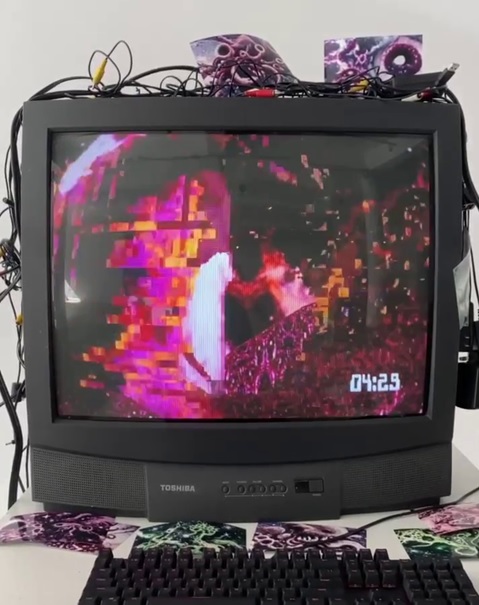

A final quick note on the debate between human creativity and machine creativity. Coming from glitch art, I believe novelty emerges from noise and error and that AI art is an evolution of glitch art, adding several levers and potentialities for mistakes. However, I also feel it is of utmost interest when juxtaposed with, for instance, collages and "hand-made" objects. That is why the cover art of the album and the game was commissioned from the visual and audio artist 11Korp [10]. 11korp creation was an isomorphic representation of the noise and the game in all its viscous depths. I strongly recommend that you readers discover his work and music.
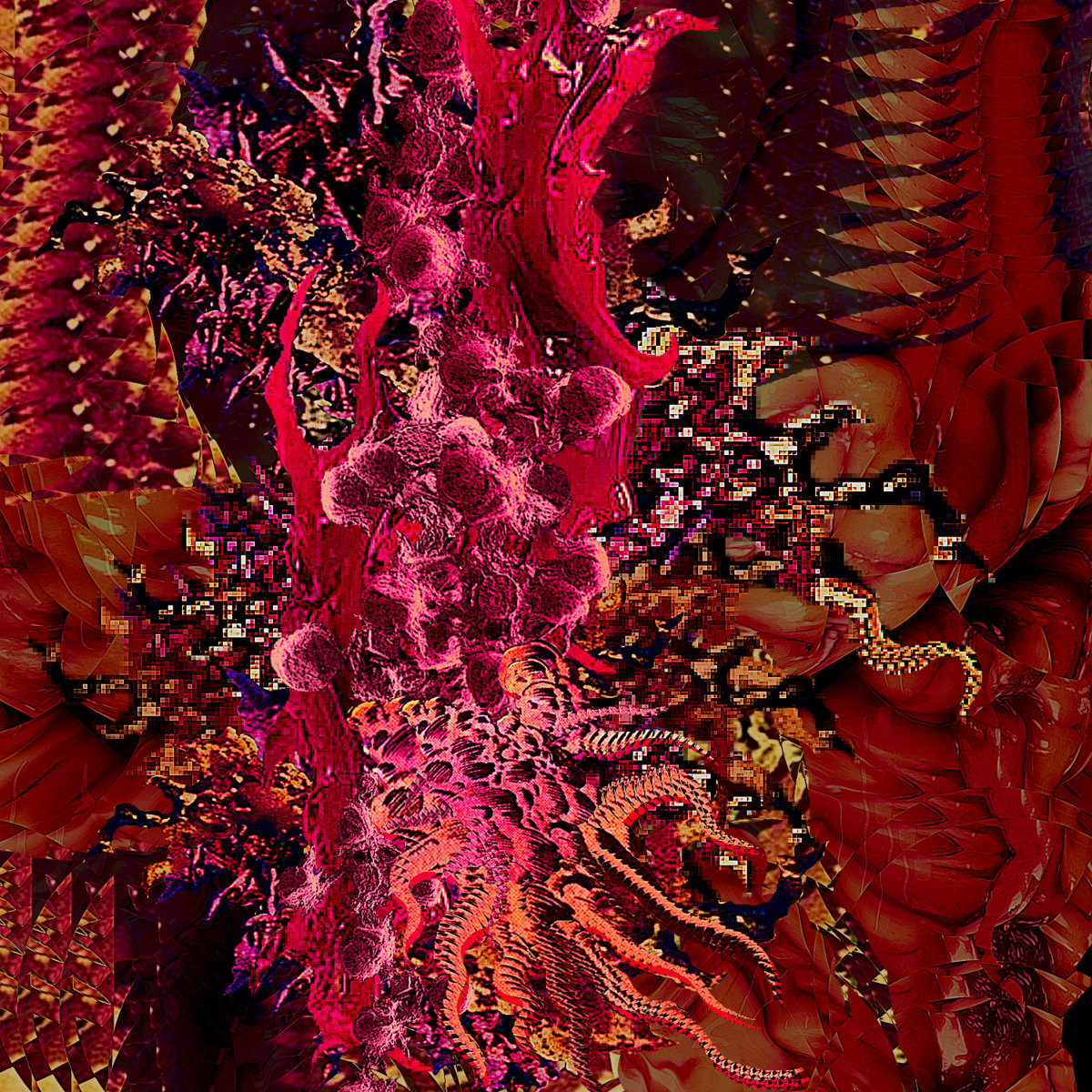
REFERENCES
Audry, S. (2021). Art in the age of machine learning. The MIT Press.
Barad, K. M. (2007). Meeting the universe halfway: quantum physics and the entanglement of matter and meaning. Duke University Press.
Behar, K. (dir.). (2016). Object-oriented feminism. University of Minnesota Press.
Birks, C. (2021). Limit cinema: transgression and the nonhuman in contemporary global film. Bloomsbury Academic.
Blanchot, M. (1983). La communauté inavouable. Éditions de Minuit.
Bogost, I. (2012). Alien phenomenology, or, What it’s like to be a thing. University of Minnesota Press.
Bown, O. (2021). Beyond the creative species: making machines that make art and music. The MIT Press.
Deleuze, G. (1988). Le pli: Leibniz et le Baroque. Editions de Minuit.
DiPiero, D. (2018). Improvisation as Contingent Encounter, Or: The Song of My Toothbrush. Critical Studies in Improvisation / Études critiques en improvisation, 12 (2)
Harman, G. (2012). Weird realism: Lovecraft and philosophy. Zero books.
Houellebecq, M. (1999). H. P. Lovecraft: contre le monde, contre la vie. Éd. J’ai lu.
Krapp, P. (2010). Gaming the Glitch: Room for Error. Dans E. Nunes (dir.), Error: Glitch, Noise, and Jam in New Media Cultures (p. 113-132). https://doi.org/10.5749/minnesota/9780816676248.003.0004
Montembeault, H. et Deslongchamps-Gagnon, M.(2019). The Walking Simulator’s Generic Experiences. Press Start, 5(2). https://press-start.gla.ac.uk/index.php/press-start/article/view/134
Navas, E. (2023). The rise of metacreativity: AI aesthetics after remix. Routledge.
Perron, B. (2018). The world of scary video games: a study in videoludic horror. Bloomsbury Academic.
Supervert. (2001). Extraterrestrial Sex Fetish. Supervert 32C.
Wilson, A. (2019). Aesthesis and perceptronium: on the entanglement of sensation, cognition, and matter. University of Minnesota Press.
Woodman, J. (2003). Modernity, Selfhood, and the Demonic: Anthropological Perspectives on « Chaos Magick » in the United Kingdom (Thesis) Goldsmiths, University of London.
[1] Houellebecq’s recent porno scandal in continuity of his thesis H. P. Lovecraft. Contre le monde, contre la vie (1991) ?
[2] https://journals.openedition.org/sdj/4573
[3] I highly recommend Nicolas Ballet’s writings on industrial culture aesthetics and “deprogramming” objectives: https://www.nicolasballet.com/publications. I discovered his work after completing the Exophilie project, but it will be referenced in future research as he brilliantly put several of my intuitions in words.
[4] https://www.theverge.com/2023/3/15/23640180/openai-gpt-4-launch-closed-research-...
[5] https://www.nytimes.com/2023/03/08/opinion/noam-chomsky-chatgpt-ai.html
[6] https://www.europenowjournal.org/2021/11/07/re-thinking-human-centric-ai-an-intr...
[8] https://kotaku.com/chatgpt-ai-openai-dan-censorship-chatbot-reddit-1850088408
[9] https://news.artnet.com/art-world/these-renderings-do-not-relate-to-reality-hito...
Get Exophilie
Exophilie
Cognisensory Training
| Status | Released |
| Author | Death Orgone |
| Genre | Adventure |
| Tags | 3D, Experimental, First-Person, glitch, Horror, Liminal space, Lovecraftian Horror, Sci-fi, Walking simulator, weird |
More posts
- Cyborg T.A.R.O.T. now available !Feb 22, 2025
- Grapefruit - New game alertDec 15, 2023
- Fu:Bar Glitch Art Festival - World PremiereOct 09, 2023
- The postmortem is public once moreSep 25, 2023
- Over 1 000 downloads todaySep 14, 2023
- New video - Absorption fœtale - Pulsion panspermique (Epilepsy warning)May 22, 2023
Comments
Log in with itch.io to leave a comment.
Fascinating process. Exophilie is unlike anything I've ever experienced. Thanks for sharing!